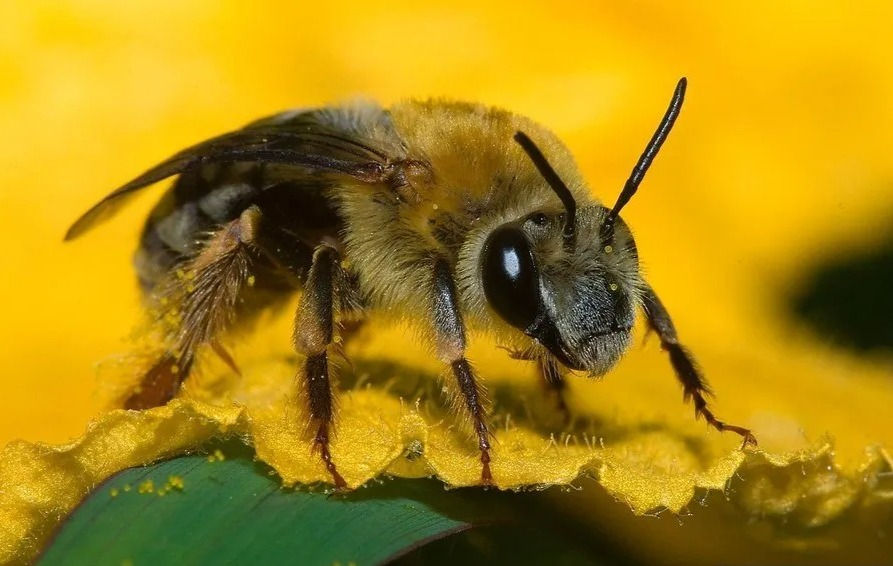Whether you call it football season or spooky season, I think we can all agree that October is really pumpkin season. It doesn't matter if you're planning on carving one into a jack-o-lantern for Halloween, having a Pumpkin spice latte on your morning drive to work, or digging out your favorite Pumpkin Pie recipe, it's nearly impossible to avoid Pumpkins this month.

Let's take a look at some of the bees that help pollinate these large gourd-eous fruits.
Fall, October in particular, is known for highlighting pumpkins. They are often the center of attention at fall festivals, hayrides, and outdoor decor.
Pumpkins hold a lot of cultural significance in the western world with millions of plants grown each year for jack-o-lantern carving at Halloween and being cooked and eaten at Thanksgiving. They are also widely referenced in fairy tales, like the Pumpkin that transformed into a carriage in Cinderella.
Pumpkin and their cousins, the Squash, are members of the Cucurbit family (along with Cucumber, Cantaloupe Melon, Gourds, and Marrow's).
Cucurbits typically have separate male and female flowers, with male flowers usually outnumbering female flowers. The flowers are typically only receptive to fertilization for a single day, and the pollen from the male flowers quickly expires, especially in hot weather. The flowers are, therefore most receptive early in the morning when the pollen is freshest, and the sun's heat has yet to wilt the delicate flowers and cause them to perish.
Across the world, Honey Bees are used for pollinating Pumpkin and Squash and perform this task well; however, they are often tempted to stray from the Pumpkin flowers by other flowering plants offering more nectar. Honey Bees are also reluctant to fly at the crack of dawn when air temperatures are often cooler. Bumble Bees with their higher metabolism and insulated bodies covered in a dense pile of fur can fly in cooler temperatures and are also important in pumpkin pollination, but like the Honey Bee they may be tempted away from the crop by other flowers which yield more nectar.
The real Pumpkin pollinator specialists, though are the solitary Peponapis and Xenoglossa bees of North America. Peponapis in ancient Greek translates as 'Pumpkin Bee.'

There are 13 species of Peponapis bee and 7 species of Xenoglossa bee native to central and Latin America. They are Cucurbit specialists feeding on a variety of wild Gourds, Squash, and Cucumber as well as farmed cultivars, including Pumpkin and Butternut Squash. Both male and female bees feed exclusively on cucurbit pollen and nectar.
These bees are slightly larger than a honey bee, covered in a dense hair pile, and fast flying even in very cool conditions. This means they can visit many more flowers than a Honey Bee during the same period. They also spend more time on each flower than most other bees, and their movements inside the flower result in more contact with the reproductive parts and increased transfer of pollen grains compared to other bees.
Peponapis Bees emerge very early in the morning, often before sunrise, and are busy pollinating Pumpkin in the near darkness before any other bees are active. The female bees excavate nest burrows in the soil around or very close to their host plants. The burrows may be a foot or more deep and contain numerous chambers where pollen is stored, and eggs are laid.
The male bees roost communally inside the male flowers and emerge at dawn from their sleep covered in pollen which they then transport to the female flowers as they search for nectar. It's thought that the male bees are more efficient at pollinating Pumpkin crops than the females because of this habit.
Populations of these bees are easy to encourage on farms by ensuring Pumpkin and Squash are grown in the same or adjacent fields year after year and by reducing damage to their nesting sites through till-free farming practices or not plowing through the nesting grounds. It's been shown that till-free farming practices can result in a three-fold increase in the numbers of Peponapis bees on Pumpkin farms compared to those using traditional plowing practices.

代发外链 提权重点击找我;
google留痕 google留痕;
Fortune Tiger Fortune Tiger;
Fortune Tiger Fortune Tiger;
Fortune Tiger Slots Fortune…
站群/ 站群;
万事达U卡办理 万事达U卡办理;
VISA银联U卡办理 VISA银联U卡办理;
U卡办理 U卡办理;
万事达U卡办理 万事达U卡办理;
VISA银联U卡办理 VISA银联U卡办理;
U卡办理 U卡办理;
온라인 슬롯 온라인 슬롯;
온라인카지노 온라인카지노;
바카라사이트 바카라사이트;
EPS Machine EPS Machine;
EPS Machine EPS Machine;
EPS Machine EPS Machine;
무료카지노 무료카지노;
무료카지노 무료카지노;
google 优化 seo技术+jingcheng-seo.com+秒收录;
Fortune Tiger Fortune Tiger;
Fortune Tiger Fortune Tiger;
Fortune Tiger Slots Fortune…
站群/ 站群
gamesimes gamesimes;
03topgame 03topgame
EPS Machine EPS Cutting…
EPS Machine EPS and…
EPP Machine EPP Shape…
Fortune Tiger Fortune Tiger;
EPS Machine EPS and…
betwin betwin;
777 777;
slots slots;
Fortune Tiger Fortune Tiger;
google 优化 seo技术+jingcheng-seo.com+秒收录;
谷歌seo优化 谷歌SEO优化+外链发布+权重提升;
Fortune Tiger Fortune Tiger;
Fortune Tiger Fortune Tiger;
Fortune Tiger Fortune Tiger;
Fortune Tiger Slots Fortune…
gamesimes gamesimes;
站群/ 站群
03topgame 03topgame
betwin betwin;
777 777;
slots slots;
Fortune Tiger Fortune Tiger;
google seo…
03topgame 03topgame
gamesimes gamesimes;
Fortune Tiger…
Fortune Tiger…
Fortune Tiger…
EPS машины…
Fortune Tiger…
EPS Machine…
EPS Machine…
EPP Machine…
EPS Machine…
EPTU Machine…
EPS Machine…
seo seo
谷歌seo推广 游戏出海seo,引流,快排,蜘蛛池租售;
Fortune Tiger…
Fortune Tiger…
Fortune Tiger…
Fortune Tiger…
Fortune Tiger…
gamesimes gamesimes;
站群/ 站群
03topgame 03topgame